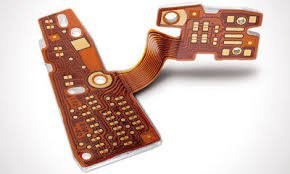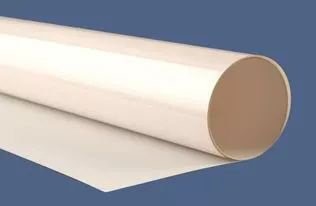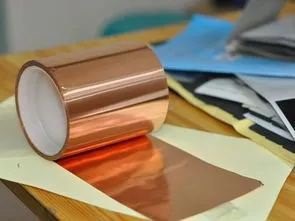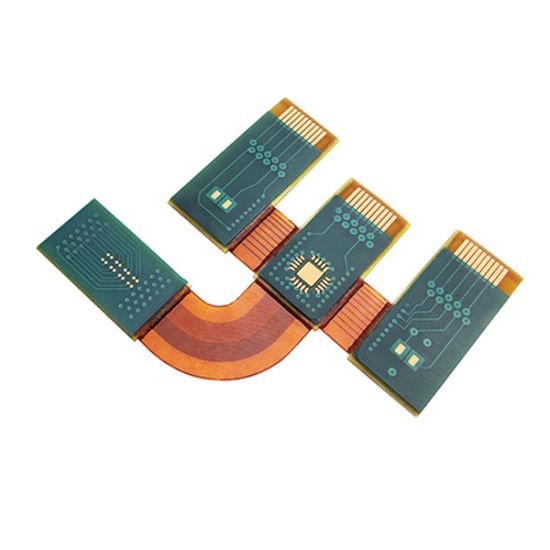What is a flexible PCB material?
The Flex PCB board usually
consists of the following five parts.

1.Insulating Substrate
The insulating substrate is a flexible
insulating film. As the insulating carrier of the circuit board, selecting a
flexible dielectric film requires a comprehensive review of the material's heat
resistance, shape-forming properties, thickness, mechanical properties, and
electrical properties. Now flex PCB is commonly used
-
PI: Polyimide, Kapton.
-
PET: PolyeSTer, Mylar.
-
PTFE: Polytetrafluoroethylene
Generally, the thickness of the film is
selected in the range of O.0127 to O.127 mm (0.5 to 5 mil).

2.Adhesive Sheet
The function of the adhesive sheet is to
bond the film and the metal foil, or the adhesive film and the film (the cover
film). Different types of adhesive sheets can be used for different film
substrates, such as polyester adhesive sheets and polyimide adhesive sheets.
Polyimide substrate adhesive sheets are divided into epoxy and acrylic. The
choice of bonding sheet mainly examines the fluidity of the material and its
thermal expansion coefficient. There is also polyimide copper-clad sheets
without adhesive sheets, which have better chemical resistance and electrical
properties.
Due to the low glass transition temperature
of the acrylic adhesive sheet, a large amount of contamination generated during
the drilling process is not easy to remove, which affects the quality of
metalized holes and other unsatisfactory materials. Therefore, the interlayer
adhesion of multilayer flexible circuits The common polyimide material of the
sheet, because it is matched with the polyimide substrate, have the same CTE
(coefficient of thermal expansion), which overcomes the problem of dimensional
instability in multilayer flexible circuits, and other properties are
satisfactory.

3.Copper Foil
The copper foil is a conductive layer
covered on an insulating base material, and a conductive circuit is formed
after selective etching. Most of such copper foils are rolled copper foil
(Rolled Copper Foil) or electrolytic copper foil (Electrodeposited Copper
Foil).
The ductility and bending resistance of
rolled copper foil are better than that of electrolytic copper foil.
According to coating online understanding,
the elongation of rolled copper foil is 20% to 45%, and the elongation of
electrolytic copper foil is 4% to 40%. The thickness of the copper foil is most
commonly 35um (1oz), there are 18um (O.5oz) thin or 70um (2oz) thick, and even
105um (30z). Electrolytic copper foil is formed by electroplating.
The crystal state of the copper particles
is vertical needle shape, which is easy to form vertical line edges during
etching, which is beneficial to the production of precision circuits. But when
the bending radius is less than 5mm or the dynamic bending, the needle-like
structure is prone to fracture.
Therefore, most of the flexible circuit substrates are rolled copper foil, whose copper particles have
a horizontal axis structure, which can adapt to multiple windings.
4.Overlay
The cover layer is an insulating protection
layer covering the surface of the flexible printed circuit board and plays a
role in protecting the surface wires and increasing the strength of the
substrate. There are generally two types of protective materials for the outer
graphics.
-
The first type is a dry film type (cover film). Polyimide material
is used, which is laminated directly to the circuit board to be protected
after etching without an adhesive. This cover film is required to be
pre-formed before pressing to expose the parts to be welded, so it cannot
meet the requirements of finer assembly.
-
The second type is the photosensitive development type. The
first type of photosensitive development is to solve the problem of
high-density assembly by exposing the welded parts through photosensitive
development after laminating the dry film with a laminator. The second
type is a liquid screen printing type covering material. Commonly used are
Thermosetting polyimide materials, and solder resist inks for
photosensitive development type flexible circuit boards.
This type of material can better meet the
requirements of flexible boards with fine pitch and high-density assembly.

5.Flex Stiffener
The reinforcing plate is bonded to the
local plate of the flexible plate, which strengthens the flexible film
substrate to support it and facilitates the connection, fixing or other
functions of the printed circuit board. The material of the reinforcing plate
is selected according to different uses. Commonly used are polyester, polyimide
sheet, epoxy glass fiber cloth board, phenolic paper board, steel plate, aluminum
plate, etc.

 Call Us Now !
Tel : +86 755 27374946
Call Us Now !
Tel : +86 755 27374946
 Order Online Now !
Email : info@bichengpcb.com
Order Online Now !
Email : info@bichengpcb.com

















